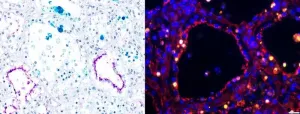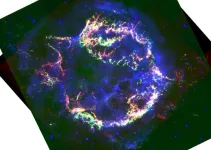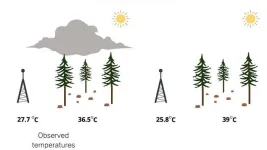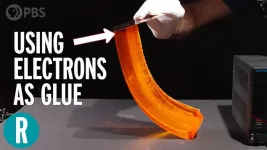(Press-News.org) AMES, Iowa – As highly pathogenic avian influenza has spread in dairy herds across the U.S., the virus is being detected in raw milk. A new study by a broad team of researchers at Iowa State University’s College of Veterinary Medicine helps explain why.
Sialic acid, a sugar molecule found on the surface of some animal cells, acts as a receptor for influenza. Without sialic acid providing an entry point to attach, invade and infect, a flu virus is unlikely to find a potential host hospitable.
Before the recent HPAI outbreak in dairy herds, there was scant research into sialic acid levels in the mammary glands of cattle. Scientists had no reason to suspect the milk-producing organs would be a good target for influenza.
“In livestock, we hadn’t usually looked in milk for viruses. Bacteria, sure. But not so much viruses,” said Eric Burrough, professor of veterinary diagnostic and production animal medicine.
A team of Iowa State researchers who examined mammary gland samples from two infected cows found a rich supply of sialic acid, which could shed light on how the virus attaches to hosts and help develop measures to slow the illness’ spread.
“We need to stop transmission, and one way to potentially do that is through milking machines. We’re not sure that’s involved with how this is spreading, but it’s one hypothesis,” said Todd Bell, professor of veterinary pathology.
All milk sold commercially in stores is pasteurized, and research consistently shows pasteurization neutralizes viruses such as influenza. But knowing cows are a biologically suitable home for the flu virus, particularly in their mammary glands, reiterates the dangers of consuming raw milk and raises questions about how milk from infected cows is discarded, Burrough said.
“The idea that the mammary glands are being passively infected is put to rest by this paper,” he said. “They’re pumping out tons of virus, and that’s a risk.”
While HPAI isn’t usually deadly for cows, it’s often fatal for birds. Since the start of the outbreak in the U.S., more than 97 million birds have been affected, according to the U.S. Department of Agriculture. Commercial poultry flocks where the virus is detected are typically euthanized.
The infected dairy cattle samples ISU researchers examined – both mammary glands and respiratory tissues – had receptors for flu strains that originate from birds as well as humans and pigs. The presence of both types of receptors poses added risks, as a single cell infected by avian and mammalian viruses could lead to potentially dangerous mutations, Bell said.
The study was published in the July edition of Emerging Infectious Diseases, the Centers for Disease Control and Prevention’s peer-reviewed journal. Thirteen of its 14 co-authors are from Iowa State, including researchers and faculty from across the College of Veterinary Medicine. Another article in the same edition of Emerging Infectious Diseases – with a list of co-authors that includes 10 ISU researchers – describes the initial diagnosis of HPAI in dairy, a finding made at the ISU Veterinary Diagnostic Laboratory this spring.
Speedy teamwork in the face of new public health threats is essential, said Rahul Nelli, research assistant professor of veterinary diagnostic and production animal medicine.
“Having different departments coming together to collaborate was key for this study and will be key for future investigations,” Nelli said.
Further research could involve influenza receptors in other species and organs, including a closer look at dairy cattle, Bell said. The just-published study is based on a handful of samples. Scientists’ understanding of how influenza affects cattle will improve as more data is collected and herds are regularly screened.
“Surveillance will be really important moving forward, not only through this event but in the years to come,” Burrough said.
END
Receptors make dairy cows a prime target for influenza, ISU team finds
2024-07-15
ELSE PRESS RELEASES FROM THIS DATE:
A new neural network makes decisions like a human would
2024-07-15
Humans make nearly 35,000 decisions every day, from whether it’s safe to cross the road to what to have for lunch. Every decision involves weighing the options, remembering similar past scenarios, and feeling reasonably confident about the right choice. What may seem like a snap decision actually comes from gathering evidence from the surrounding environment. And often the same person makes different decisions in the same scenarios at different times.
Neural networks do the opposite, making the same decisions each time. Now, Georgia Tech researchers in Associate Professor Dobromir Rahnev’s lab are ...
Wojtusiak to use artificial intelligence to help caregivers with social isolation
2024-07-15
Janusz Wojtusiak, Professor, Health Administration and Policy, College of Public Health, is set to receive funding for the project: “An Artificial Intelligence Solution to Social Isolation and Longlines of Caregivers of People with Dementia.”
Wojtusiak and his graduate student Ghaida Alsadah will lay the foundation for a large study aimed at utilizing AI methods to address social isolation and loneliness among people who care for those with Alzheimer’s Disease and those suffering from dementia.
Addressing ...
You're just a stick figure to this camera
2024-07-15
Images
A new camera could prevent companies from collecting embarrassing and identifiable photos and videos from devices like smart home cameras and robotic vacuums. It's called PrivacyLens and was made by University of Michigan engineers.
PrivacyLens uses both a standard video camera and a heat-sensing camera to spot people in images from their body temperature. The person's likeness is then completely replaced by a generic stick figure, whose movements mirror those of the person it stands in for. The accurately animated stick figure allows a device relying on the ...
Scorching storms on distant worlds revealed in new detail
2024-07-15
Astronomers have created the most detailed weather report so far for two distant worlds beyond our own solar system.
The international study – the first of its kind – reveals the extreme atmospheric conditions on the celestial objects, which are swathed in swirling clouds of hot sand amid temperatures of 950C.
Using NASA’s powerful James Webb Space Telescope (JWST), researchers set out to capture the weather on a pair of brown dwarfs – cosmic bodies that are bigger than planets but smaller than stars.
These brown dwarfs, named collectively ...
JWST unveils stunning ejecta and CO structures in Cassiopeia A's young supernova
2024-07-15
July 15, 2024, Mountain View, CA -- The SETI Institute announced the latest findings from the James Webb Space Telescope (JWST) of the supernova remnant, Cassiopeia A (Cas A). These observations of the youngest known core collapse supernova in the Milky Way provide insights into the conditions that lead to the formation and destruction of molecules and dust within supernova ejecta. The study’s findings change our understanding of dust formation in the early universe in the galaxies detected by JWST 300 million years after the Big Bang. ...
UC Irvine Earth system scientists discover missing piece in climate models
2024-07-15
Irvine, Calif., July 15, 2024 — As the planet continues to warm due to human-driven climate change, accurate computer climate models will be key in helping illuminate exactly how the climate will continue to be altered in the years ahead.
In a study published in the Journal of Geophysical Research: Atmospheres, a team led by researchers from the UC Irvine Department of Earth System Science and the University of Michigan Department of Climate and Space Sciences and Engineering reveal how a climate model commonly used by geoscientists currently overestimates ...
Wildfire smoke has a silver lining: It can help protect vulnerable tree seedlings
2024-07-15
CORVALLIS, Ore. – Forest scientists at Oregon State University studying tree regeneration have found that wildfire smoke comes with an unexpected benefit: It has a cooling capacity that can make life easier for vulnerable seedlings.
An OSU College of Forestry collaboration led by faculty research assistant Amanda Brackett made the discovery while working to determine the effect of forest canopy cover on summer maximum temperatures near ground level.
The study’s goal was to describe how heat waves and other future climate conditions might affect canopy cover’s influence on temperature. The scientists used previously established heat stress responses of seedlings from ...
How does superglue work, and what the heck is electroadhesion? (video)
2024-07-15
WASHINGTON, July 15, 2024 — How would you stick a slice of banana to a sheet of copper? Until a few months ago, you couldn’t. But a new discovery called “hard-soft electroadhesion” enables chemists to stick almost any hydrogel to almost any metal, using nothing but an electric current. And you can unstick the materials simply by reversing the current. Recently reported in ACS Central Science, this astonishingly general phenomenon works with a wide variety of gels (including fruits, vegetables, meat and fish) and conductors (including metals and graphite). Join our host George as he attempts to replicate electroadhesion in his basement ...
Progression from pre-symptomatic to clinical type 1 diabetes after COVID-19 infection
2024-07-15
About The Study: Follow-up of youth with pre-symptomatic type 1 diabetes demonstrated that the COVID-19 pandemic was associated with an accelerated progression to clinical disease and that this acceleration was confined to those with COVID-19. Further studies are required to determine whether COVID-19 also accelerates progression to type 1 diabetes in adults and whether vaccination and monitoring for COVID-19 symptoms should be considered for individuals with pre-symptomatic type 1 diabetes.
Corresponding ...
Mental health of transgender youth following gender identity milestones by level of family support
2024-07-15
About The Study: The results of this study demonstrate that without a supportive family environment, gender identity development increases the risk of transgender youth attempting suicide or running away from home. Social services and community resources to establish supportive relationships between transgender children and their parents are essential.
Corresponding Author: To contact the corresponding author, Travis Campbell, Ph.D., email campbelt1@sou.edu.
To access the embargoed study: Visit our For The Media website at this link https://media.jamanetwork.com/
(doi:10.1001/jamapediatrics.2024.2035)
Editor’s ...



